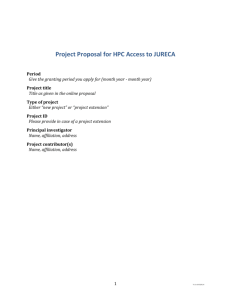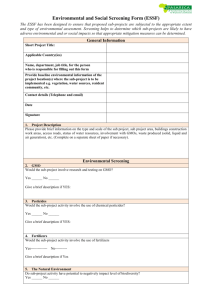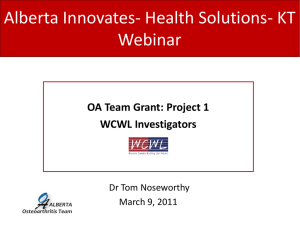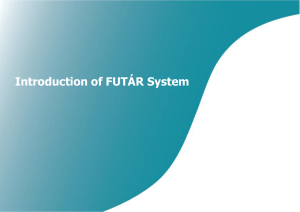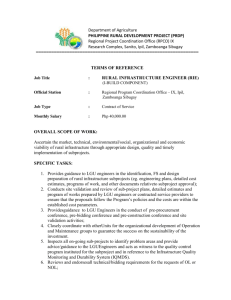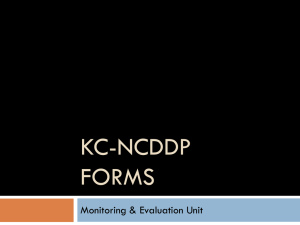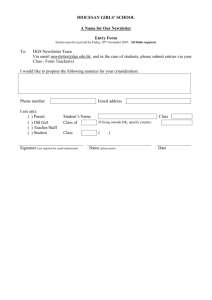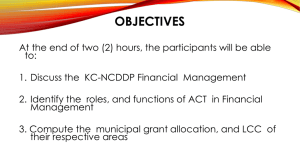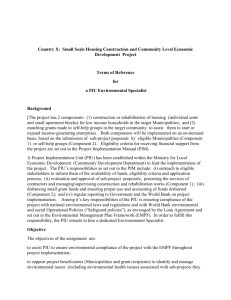Huawei Wireless Network User Group Newsletter, Oct 2012
advertisement
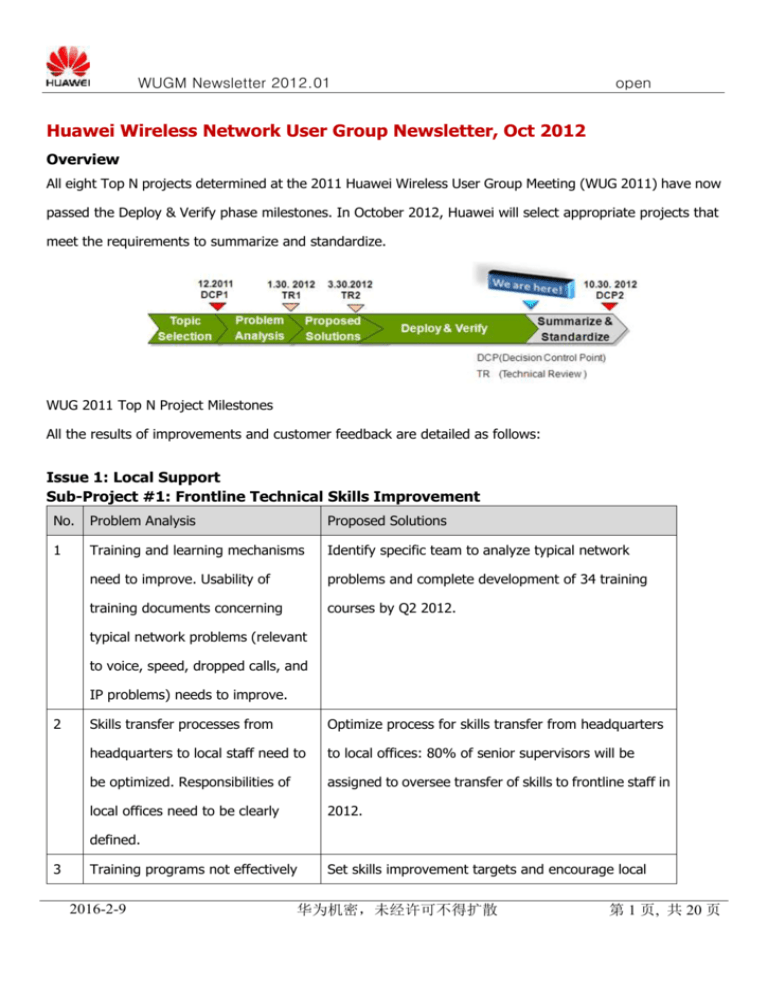
WUGM Newsletter 2012.01 open Huawei Wireless Network User Group Newsletter, Oct 2012 Overview All eight Top N projects determined at the 2011 Huawei Wireless User Group Meeting (WUG 2011) have now passed the Deploy & Verify phase milestones. In October 2012, Huawei will select appropriate projects that meet the requirements to summarize and standardize. WUG 2011 Top N Project Milestones All the results of improvements and customer feedback are detailed as follows: Issue 1: Local Support Sub-Project #1: Frontline Technical Skills Improvement No. Problem Analysis Proposed Solutions 1 Training and learning mechanisms Identify specific team to analyze typical network need to improve. Usability of problems and complete development of 34 training training documents concerning courses by Q2 2012. typical network problems (relevant to voice, speed, dropped calls, and IP problems) needs to improve. 2 Skills transfer processes from Optimize process for skills transfer from headquarters headquarters to local staff need to to local offices: 80% of senior supervisors will be be optimized. Responsibilities of assigned to oversee transfer of skills to frontline staff in local offices need to be clearly 2012. defined. 3 Training programs not effectively 2016-2-9 Set skills improvement targets and encourage local 华为机密,未经许可不得扩散 第 1 页, 共 20 页 WUGM Newsletter 2012.01 No. open Problem Analysis Proposed Solutions implemented at local offices. staff to self-study. Organize headquarters experts to Improvement targets for local staff deliver training at local offices on a regular basis (550 skills are not clearly defined. local staff will receive training in 2012). Select key local staff to attend long-term training programs at R&D on a regular basis (70 key local staff will receive in 2012). Sub-Project #1 Result: New 34 typical troubleshooting guides have been published on a support website. We have pushed them to the frontline through on-site training, the support website and emails to help engineers improve their technical skills. So far, 75% of senior supervisors have been assigned and are working on skills transfers. Huawei has trained 4,223 staff using four training methods. The total number of trained engineers increased by 100%. After one year of improvements: The number of qualified senior engineers increased by 50%; and qualified mid-level engineers increased by 37%; The frontline-resolved critical issue rate increased by 8% 2016-2-9 华为机密,未经许可不得扩散 第 2 页, 共 20 页 WUGM Newsletter 2012.01 2016-2-9 华为机密,未经许可不得扩散 open 第 3 页, 共 20 页 WUGM Newsletter 2012.01 open Sub-Project #2: Standardized Network Operations No. Problem Analysis Proposed Solutions 1 Part-time roles exist in some Reinforce project-based operations of network maintenance and maintenance projects. Update engineering delivery teams, appointment of maintenance teams for resulting in insufficient input for Q2 2012. network maintenance. 2 Routine network maintenance is not Establish mechanism to implement effective enough, resulting in network maintenance Standard possible risks that become Operation Procedures (SOP) on a problems. semi-annual basis. Sub-Project #2 Result: This year, we have set up maintenance teams for more networks. The changeover rate for Operation Directors has decreased from 40% to 12%, and the changeover rate for Technical Directors decreased from 36% to 9%. Implemented Maintenance SOP on 174 networks during H1 2012. Number of critical issues decreased by 50%, with a 20% drop in time for recovery. 2016-2-9 华为机密,未经许可不得扩散 第 4 页, 共 20 页 WUGM Newsletter 2012.01 open Sub-Project #3: Project Delivery Improvement No. Problem Analysis Proposed Solutions 1 Local delivery teams do not meet five Headquarters to establish five subject matter teams metrics for project delivery: network to develop corresponding guide documents and tools design, site solution, swap solution, and transfer required subject matter skills to local deployment solution, and acceptance teams to enable local teams to independently perform testing (they are greatly dependent these tasks (for at least 70 projects in 2012). on headquarters support in these areas). Sub-Project #3 Result: 2016-2-9 华为机密,未经许可不得扩散 第 5 页, 共 20 页 WUGM Newsletter 2012.01 open Optimized delivery of five weak solution areas: Network Design, Effective Site Solutions, Effective Testing Work, Effective Swapping and Effective BTS Deployment. Practiced 106 projects and trained 1,036 engineers. For Effective Swapping: correct mapping rate reached 98% after delivery of an Algorithm Parameter Mapping solution; issues related to antenna system installations were reduced by 90% after delivery of an Antenna System Check solution. Issue 2: Documentation Sub-Project #1: Provide “Engineering Guidelines” in Feature Parameter Description No. Problem Analysis Proposed Solutions 1 Standardization Improve writing standards, specify requirements requirements for the for content accuracy, and add example cases as content of documents reference. should be made clearer. 2 In “Parameter Reference” In SingleRAN7.0 “Parameter Reference”, documents, description of improvements will be made to the description of restrictions between parameter interdependencies between frequently parameters needs to used commands. improve. In SingleRAN8.0 “Parameter Reference”, improvements will be made in the description of parameter interdependencies involved in all major commercially used features. 3 In “MML Command In SingleRAN7.0 “MML Command Reference” Reference” documents, documents, check default values for all default values for some parameters, locate default values for parameters parameters need to be related to the set command, and complete all completed. missing default values. Sub-Project #1 Results: The template’s optimization of “Feature Parameter Description” has been achieved: 2016-2-9 华为机密,未经许可不得扩散 第 6 页, 共 20 页 WUGM Newsletter 2012.01 open Detailed descriptions for engineering guideline have been added to “Feature Parameter Description,” which was implemented in the following versions: SingleRAN 6.0 (GBSS13.0 / RAN13.0 / eRAN2.1) SingleRAN 7.0 (GBSS14.0 / RAN14.0 / eRAN3.0) Feedback from customers: Thanks, improvement look very promising, you should publish it to all the customers. (From Teliasonera Finland) Implemented enhancements are very much appreciated by DT.Design Team had the chance to work with the enhanced FPD already. (From T-Mobile Germany) Sub-Project #2: Optimize Parameter Reference & MML Command Reference No. Problem Analysis Proposed Solutions 1 Document template needs to Analyze missing content in instructions for engineering improve to meet the deployment of features, optimize document template. engineering needs of customers. 2 The Feature Configuration Add the following information about engineering deployment part includes only descriptions to the new and enhanced features in the SingleRAN7.0 about "activation, “Feature Parameter Description” documents: deactivation, and Feature enablement recommendation: advises when and verification," which cannot where to enable a feature or a combination of features adequately guide feature Information collection prior to deployment: provides deployment. information to be collected before a feature is deployed 2016-2-9 华为机密,未经许可不得扩散 第 7 页, 共 20 页 WUGM Newsletter 2012.01 open Network planning: provides recommendations, principles, key tips, and restriction information about radio frequency planning, networking planning, and hardware planning Feature deployment: describes processes, requirements, data preparation, precautions, hardware installation, activation, configuration, enablement observations, and adjustment for feature deployment Performance optimization: provides information about performance monitoring and guidance for incumbent network parameter adjustment Sub-Project #2 Results: Optimized more than 5,000 unclear descriptions, providing more accurate information. Documentation issues were reduced by 30%. For example: Added more than 400 parameter relationships, ensuring visibility for all relevant parameter changes. For example: Added more than 300 default values for SET commands. For example: Feedback from customers: There have been significant improvements in the amount of details provided in the documentation (From Bell Canada) Sub-Project #3: Streamline Document Obtaining & Feedback Channel No. Problem Analysis 2016-2-9 Proposed Solutions 华为机密,未经许可不得扩散 第 8 页, 共 20 页 WUGM Newsletter 2012.01 1 open Information about From SingleRAN7.0 on, add information about access documentation organizations channel to the document packages on the support website and access channel to product for the LMT and M2000 clients. documentation are not well From SingleRAN8.0 on, embed HedEx documentation in communicated to all local product packages to implement automatic installation and offices and customers. upgrade HedEx documentation. (Huawei e-document Explorer) Publicize Huawei’s documentation system and access to documentation for local offices and customers on a regular basis. 2 Some customers do not have Review customers’ accounts and permissions for the necessary permissions for the support website and optimize the account application Huawei Support website. methods. Sub-Project #3 Results: The following platform has been improved: HedEx: Added documentation overview chapter for how to obtain different components (SingleRAN7.0). M2000/LMT Software: Automatic reminders of document package download, whenever you upgrade the network (SingleRAN8.0). Customers can much more easily obtain documentation: Streamlined more than 30,000 old customer accounts. Added more than 3,000 new customer accounts. Issue 3: O&M (E2E Network Management) Sub-Project #1: Control of Northbound Interface Changes No. Problem Analysis Proposed Solutions 1 O&M baseline needs to be Improve O&M baseline in Q2 2012: reinforce O&M planning improved. and design baseline restrictions. From SingleRAN8.0 on, realize consistent alarms and 2016-2-9 华为机密,未经许可不得扩散 第 9 页, 共 20 页 WUGM Newsletter 2012.01 open consistent software upgrade model. 2 O&M changes and Minimize changes of O&M model and northbound interfaces interconnection interfaces for SingleRAN7.0. changes occur due to software upgrade. 3 Northbound interfaces are not Northbound control team monitors the freezing of strictly frozen within three northbound interfaces within three months prior to GA on a months prior to the GA point. regular basis and ensures the accuracy of interface documents. Sub-Project #1 Result: To resolve O&M planning and design restrictions, we outputted an O&M baseline “Operational Process and Pain Point Overview” to guide SingleRAN 8.0 planning and design. Achieved minimal changes to O&M models and northbound interfaces. Succeeded to freeze northbound interfaces within three months prior to GA in SingleRAN 7.0. Sub-Project #2: O&M Efficiency Improvement No. Problem Analysis Proposed Solutions 1 Focus on MBB O&M Capacity Visibility: Through use of the network capacity monitor tool, scenarios, provide high detected the cell with capacity bottleneck on GIS system, and auto efficiency features analysis issue by network KPI Efficient Network Tuning: Optimized the BTS refarming solution, the new program will improve the efficiency by 90% 2016-2-9 华为机密,未经许可不得扩散 第 10 页, 共 20 页 WUGM Newsletter 2012.01 open Whole Network Configuration Verification: Data consistency across OSS system verification to ensure the consistency and validity of the data configuration of the entire network to protect the terminal user quality of service and experience Sub-Project #2 Result: Capacity Visibility for Precise Expansion: New PRS (Performance Surveillance) tool provides MBB capacity visibility and locates RAN bottlenecks. Efficient Network Tuning: Time reduced to 1/10 Simplified MML Commands and Optimized Mechanism Cross-OSS Parameter Consistency Check: Time significantly reduced Reduced time spent on auditing whole-network parameter consistency from 24 hours to 1 hour Sub-Project #3: GUI Usability Improvement No. Problem Analysis Proposed Solutions 1 GUI design does not meet Develop unified GUI specifications and standards; customers’ habits. optimize the iManager 12.0 before September 30, 2012. Sub-Project #3 Result: Improved in five aspects; 110 GUI improvement requirements have been fulfilled for iManager 12.0. 2016-2-9 华为机密,未经许可不得扩散 第 11 页, 共 20 页 WUGM Newsletter 2012.01 open Feedback from customer: Operations teams have stated that improvements for the M2000 GUI over the last release (R12) are very impressive and do meet most requirements. (From DT) Issue 4: Capacity Sub-Project #1: Improve Capacity Planning Capability No. Problem Analysis Capacity visibility tools 1 or services need to be developed. Proposed Solutions Include capacity visibility tools to be used for regular planning. Provide capacity visibility reports in the Performance Surveillance (PRS) by Q3 2012 and GUI support in 2013. Give guidance service about capacity planning to customers by Q3 2012. Sub-Project #1 Result: Capacity monitor will be changed from a counter to a GUI in 2012 Q3, which is clearer in observing resource usage and finding bottlenecks. Close to a 20% improvement in air interface capacity in RAN14.0. Sub-Project #2: Improve Capacity Processing Efficiency No. Problem Analysis Proposed Solutions 1 A resource sharing mechanism For SinleRAN8.0, launch new BSC6910 that supports dynamic should be developed between configuration of CP/UP and CP pool, and BSC6910 supports RNCs and between SPUs within forming the RNC pool with BSC6900. the same RNCs. 2016-2-9 华为机密,未经许可不得扩散 第 12 页, 共 20 页 WUGM Newsletter 2012.01 open No. Problem Analysis Proposed Solutions 2 NodeB signaling processing Increase NodeB signaling processing capability of SingleRAN7.0 capability needs to improve. to ten times higher than that of SingleRAN6.0. Sub-Project #2 Result: BSC6910 (new RNC) will improve capacity efficiency by supporting pools on three levels: dynamic CP/UP on one board, CP pool and UP pool between boards in RNC, pool between RNCs. BSC6910 will be GA in 2013 Q2. Signaling capacity for NodeB has been improved to 1,500 CNBAP/s from 250 CNBAP/s for SingleRAN 8.0 with new hardware. Sub-Project #3: Ensure KPIs for Key Events No. Problem Analysis Proposed Solutions 1 VIP assurance needs to For SingleRAN7.0, ensure system stability and service experience be improved and service through intelligent access controls. For SingleRAN8.0, provide resource assurance solutions need reserves for VIP customers to ensure access and service experience. to be optimized. Sub-Project #3 Result: In RAN 14.0, new features are provided to ensure KPIs and VIP user experience during key events: Intelligent Access Control doubles access users; Platinum User Experience Guarantee solution provides assurance for VIP users. 2016-2-9 华为机密,未经许可不得扩散 第 13 页, 共 20 页 WUGM Newsletter 2012.01 open Issue 5: Knowledge Sharing Sub-Project #1: Establish a Two-Way Interaction Platform No. Problem Analysis Proposed Solutions 1 Knowledge sharing needs “Knowledge Sharing” is an all-encompassing topic concerning our to be optimized to meet customers’ expectations to be able to share information with each other customer concerns, like on a variety of issues such as: industry changes, Operations experience and industry best practices operation experience, etc. Network issues and advice for efficient operations of Huawei networks Applications of new technologies Industry developments that change network deployment and operations 2 Knowledge sharing needs The current plan is to develop a channel within the existing framework of to establish a two-way Huawei’s web services, and allow registered customers to search and interaction platform. select information according to their own interests Sub-Project #1 Result: A customer knowledge sharing forum is available now Three main topics: industry insight, wireless technologies and O&M experience; more than 30 articles available at its launch Visit http://forum.huawei.com/ for registering, log-in and learning or sharing experience Sub-Project #2: Local Expert Training Programs No. Problem Analysis Proposed Solutions 1 Huawei need to increase Huawei improve staff skill by the following ways: skills among the people we Sparkle 2012 training program meet “Zhu Jian Action” training program Global wireless expert (GEO) joint meeting Sub-Project #2 Result: “Sparkle” local face to face training has been delivered during the first half of 2012 as follows: 2016-2-9 华为机密,未经许可不得扩散 第 14 页, 共 20 页 WUGM Newsletter 2012.01 open 80 classes in 13 regions Staff coverage rate: 67.7% Special training in 10 regions: Done Local staff satisfaction score: 78.1 “Zhu Jian Action” training program (HQ-Local remote training) has been running since 2012 Q3 148 classes and 6,106 attendances from May to Aug. in total 40+ sessions each month, nearly 40 attendees per session GUL classes: 50%, RF network planning: 27% Global wireless experts (GEO) meeting every month: More than 170 attendees globally each month Issue 6: Software Upgrade/Patches Sub-Project #1: Patch Implementation Improvement No. Problem Analysis Proposed Solutions 1 A regular patch Huawei’s Assurance & Managed Service Department (AMS) implementation issues an official document that requires that patch communication mechanism implementation plans for the future three months must be should be established at developed with customers for commercial networks. local offices. 2 Unified plans for patch Local service operation directors or CTOs update patch implementation for different implementation plans for all the product lines on the networks products should be made. they are responsible for and conduct regular communication with customers. Sub-Project #1 Result: At the end of 2011, the notification Notice Concerning Implementing Version & Patch Management was published which demands frontline engineers communicate three-month version and patch plans to the customer. Until now, 95% of wireless networks have been successfully implemented. 2016-2-9 华为机密,未经许可不得扩散 第 15 页, 共 20 页 WUGM Newsletter 2012.01 open Sub-Project #2: Patch Planning Improvement No. Problem Analysis Proposed Solutions 1 Patches are not released by Fully consider risks in patch plans and communicate with headquarters on time as planned. customers in advance when exceptions occur. 2 Patch release notes are not updated Improve patch release process from headquarters and in time when patch scope changes. require that Bug Fix Lists should be updated on time when patch scope changes. Sub-Project #2 Result: By optimizing the patch development process, patch planning punctuality rate reached zero deviations since June 2012. By improving IT platform efficiency, frontline engineers can get patch plans and all fixed-bug lists ahead of time. Sub-Project #3: Patch Quality Improvement No. Problem Analysis Proposed Solutions 1 Design of patch application Improve library of patch application scenarios to guide scenarios needs to improve. development design and verification Sub-Project #3 Result: In order to enhance the quality of patches, we designed test strategies based on patch requirements, commercial scenarios and patch documents. Through September 2012, the number of network problems has been reduced by 33.4%, and the number of required patches has been reduced by 16.4%. 2016-2-9 华为机密,未经许可不得扩散 第 16 页, 共 20 页 WUGM Newsletter 2012.01 open Issue 7: Lifecycle Sub-Project #1: EOX Communication No. Problem Analysis Proposed Solutions 1 The EOX operation process Optimize the EOX operation process and clearly define the initiation should be optimized and some time, operation period, organizations, and local offices’ local offices have not effectively responsibilities. Promote local offices to actively communicate with performed their EOX customers on a regular basis and conduct the first round of communication duties. communication in Q2 2012. Sub-Project #1 Result: In 2012, we developed a new dedicated IT support system (Front Communication Workflow) to support EOX communications. Based on the new platform, EOX information is exchanged more efficiently and communication processes are visible and clear for each step. We also added clear schedules for EOX communications in the EOX/PCN operation process (EOX communications twice a year). 2012 H1 EOX communications were based on new IT systems. Customer communications will be finished by 9/30/2012. Sub-Project #2: EOX Documents Quality Improvement No. Problem Analysis Proposed Solutions 1 Capability of document Develop the requirements for writing EOX documents and require SE writers needs to improve participation as a key role. and design of document Optimize EOX document templates and add key information that templates should be customers focus on (such as the specifications and compatibility of optimized. new hardware and suggestions for customers after hardware 2016-2-9 华为机密,未经许可不得扩散 第 17 页, 共 20 页 WUGM Newsletter 2012.01 open replacement). Improve review checklist for EOX documents. Sub-Project #2 Result: Based on the feedback from frontline staff and customers, we optimized the EOX document template by adding descriptions: Compatibilities Specification comparisons Customer changes Response suggestions We have released the latest EOX documents for 2012 H1. Sub-Project #3: Hardware Compatibility Enhancement No. Problem Analysis Proposed Solutions 1 Communication with customers Collect and summarize customer feedback, complete design about O&M is not effective specifications, and improve hardware compatibility by Q2 2012. enough and design specifications need to improve. Sub-Project #3 Result: In 2012, we developed compatibility criteria to maintain hardware design standards and reduce the impact of hardware upgrades on customer network operations. Issue 8: Smartphone Ecosystem/Industry Alignment Sub-Project #1: Hot Topic Issues Collected & Solution Promoted No. Problem Analysis Proposed Solutions 1 Platform and solutions Regular meetings Hot topic issues collection Sub-Project #1 Result: Operator hot topic issues collected Solutions promoted accordingly 2016-2-9 华为机密,未经许可不得扩散 第 18 页, 共 20 页 WUGM Newsletter 2012.01 open Series of whitepapers for better smartphone networks and user experience released based on real network issues Sub-Project #2: Industrywide Smartphone Initiative No. Problem Analysis Proposed Solutions 1 Industrywide Smartphone Proposed cooperation Initiative Discussing within industries bodies Sub-Project #2 Result: Cooperation proposed to identify: Common issues found in the industry created by Smartphones Industry requirements that can address those issues Sub-Project #3: mLAB Openness, Innovative Solutions, Apps Evaluation System No. Problem Analysis Proposed Solutions 1 mLAB Openness, mLABs established for long-term openness, innovative solutions Innovative Solutions, Apps Creation of an Apps Evaluation System using the Apps Insider tool Evaluation System Sub-Project #3 Result: Established mLABs in Shanghai and Silicon Valley mLABs outputted series of insight reports about: FaceTime, iOS and Android behavior analysis, future network traffic forecasts Completed development of Apps Insider tool; Apps Insider used to analyze and generation solutions for better network friendliness and more balanced user experience 2016-2-9 华为机密,未经许可不得扩散 第 19 页, 共 20 页 WUGM Newsletter 2012.01 open The main white papers can be downloaded from Huawei website: http://www.huawei.com/en/industry/huawei-voices/index.htm Paper1: Analyzing the Network Friendliness of Mobile Applications Paper2: Smartphone Solutions white paper Paper3: Future smartphone solution white paper For all Top Issues spanning from 2011 to 2012, Huawei would like to thank the following operators for their collaboration and support: TELUS, Telenor, Bell Canada, Ufone, Vodafone, Belgacom, Zain, Telefonica, Maxis, Deutsche Telekom, TeliaSonera, Optus, Mobinil, FT&Orange, PCCW, Etisalat, Robi Axiata, China Unicom, and BYT. Their help has allowed Huawei to further improve itself and become the industry-leading company that it is today. As always, your feedback on our progress is welcome. Please send any comments to: WirelessUserGroup@huawei.com View the previous newsletter 2016-2-9 华为机密,未经许可不得扩散 第 20 页, 共 20 页
